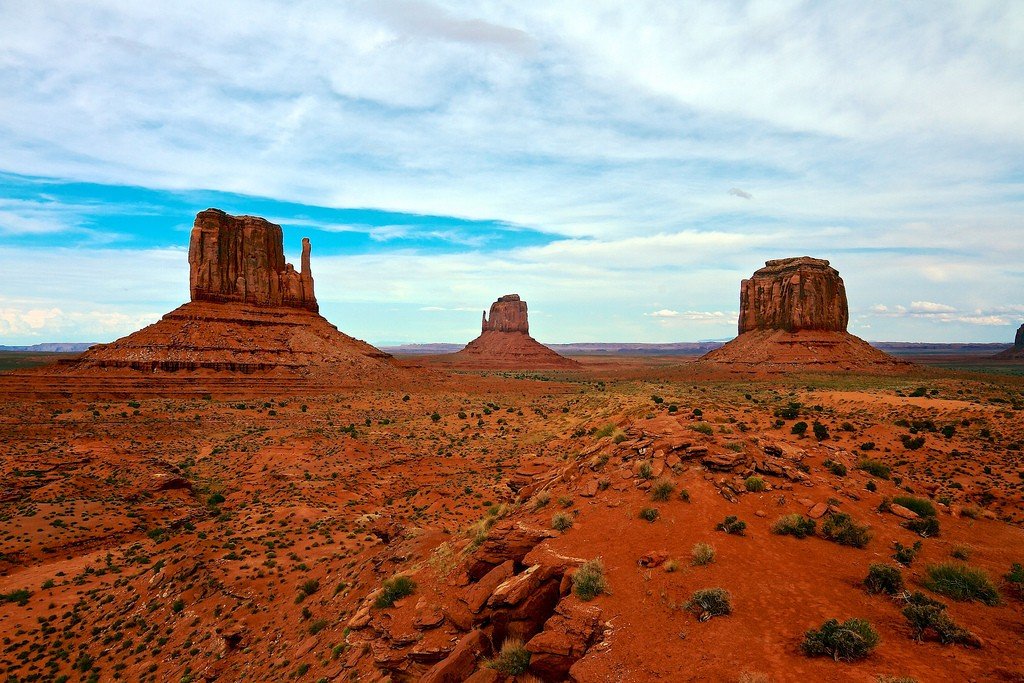Monument Valley
Monument Valley is an area of extraordinary sandstone cliffs rising to a height of 300 meters. It is one of the most familiar images of the American West. That’s not to say Monument Valley is a valley in the traditional sense. Rather, it is a giant flat desert plain, in the middle of which rise the sandstone cliffs, the last of the mountains that once occupied the entire area.










Video: Monument Valley
General Information
The uniqueness of Monument Valley is directly related to its origin. It is hard to imagine that 250 million years ago there was a sea here. At the bottom of this prehistoric body of water, silt was collected, under the weight of which sand was compressed into porous sandstone. After a time unimaginable for man and short for the geologic history of the earth, the sandstone was transformed into shale. Nearly 70 million years ago, the earth’s crust was violently uplifted, and fresh air and sunshine reigned where the sea floor had been. The view must have been amazing – a huge sandstone plateau with a surface layer of shale and clastic rocks was destroyed by rainstorms, gnawed by small rivers and sanded to a shine by the wind. At last the rocky columns took the place of the indestructible majesty.
.The valley is known the world over and, of course, to you thanks to western movies starring the legendary John Wayne and other Hollywood cowboys. Monument Valley’s landscape is one of the 100 most famous natural wonders. Standing alone in a flat sandy desert, the huge red table mountains, sharp peaks and steep slopes have been captured countless times for movies and colorful magazines. But even if you have seen these pictures, you will be amazed by the reality of the deep vivid colors and the variety of shapes of these formations. The best Marlboro cigarette ads were filmed here, too.
.The valley is located on the reservation of the Navajo Indians (Navajo), who have the exclusive right to escort tours in the reserve, so it is recommended to arrange a guide in advance or upon arrival at the site. Without a guide, unlike in national parks, you get much less for the same or higher price of admission. For example, exploring Monument Valley takes about an hour. You can only do one small lap by car with several stops along a sandy, unpaved road. The information brochure you receive at the entrance contains many prohibitions and warnings: no rock climbing, no hiking as there are no hiking trails, no driving off the trail, no entering homes or photographing Indians, no alcoholic beverages on Navajo land, and so on.
.Tourists see Monument Valley as a cluster of fantastic dilapidated castles, ancient temples, modern skyscrapers, columns and spires. In fact, the unusual shape of the structures was chosen by nature without any hindsight.
.
This does not prevent locals from “humanizing” geological monuments with names: Castle rock (Castle rock, an imposing massif with a flat top, 300 m high, topped with crenellated turrets), Rukavichki (Rukavichki, rock formations standing side by side), Broody (Broody, similar to a chicken), Merrick and Mitchel (Mitchel), natural copies of giant tombstones, Prioress, Three Sisters and so on.
Mainly the attractions of Monument Valley are concentrated around the town of Goulding. This settlement, 250 kilometers away from the nearest city (Flagstaff in Arizona), was founded in 1923 as a trading post with the Indians. Today, the economy is based on tourism.
.The views from the visitor center are spectacular, but you can explore the park by taking the Valley Drive, a 27 km long road. It winds amongst spectacular cliffs and bizarre rocks, including the famous Totem Pole, a huge spire 91 meters high and only a few meters wide. Ancient cave dwellings, natural arches and petroglyphs can be viewed here.
.Monument Valley has changed over the last century, as erosion processes are ongoing. It may well happen that hundreds of years from now only a flat, dreary plain will be left in place of the majestic sandstone plateaus, hurry up…
.
